

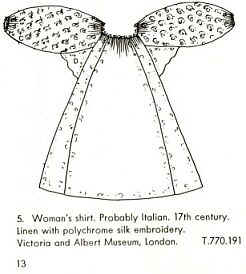
The pattern layout for this garment appears to be very similar to this diagram from Dorothy Burnham's 'Cut My Cote'. Diagram based on an extant chemise housed at the Victoria and Albert Museum, London. Dated to the 17th century.
The Chemise
Now to the chemise!
Call them what you like, chemise, camicia,
smock, they all perform the same function. Regional
differences are a taken in the execution of any style. In most
Venetian portraits the
chemise appears to be rather full to give that lovely gathered effect in the
front opening of the dress. Chemise was made mostly of linen, although
silk might have been used, cotton was
not common and not as likely to have been used.
Their function was simple. To protect the outer garment from body grease and soiling, and, to make the wearer more comfortable from the elements, and parts of their outer garments. The humble chemise was also another way of displaying your wealth or talent as an embroiderer and seamstress. This and the smock were the garments most often laundered, not the outer wear.

Lines of embroidery decorate the seams and the hem of this exquisite chemise. This is very similar to the lines of embroidery in the Vecellio woodcut. This is not the style of chemise that is generally worn under a Venetian gown of the late sixteenth century. The neckline is not open as the ones seen in portraiture of the time. This does not mean that it is not a Venetian item as is indicated by the Metropolitan Museum of Art's attribution. It does imply however that this garment was intended to be worn in the home only as bed attire or under a loose gown, possibly for a woman's period of 'confinement' late in pregnancy.
Due to legal reasons, see copyright, I am unable to web other better images of this particular garment that give better detail. I can however give a detailed description of the garment.
Base fabric is a white tabby weave linen. The body measures 111cm long. Under arm width is 63cm, 230cm at the hem. The sleeves are 66cm wide. Cut of the garment is much as we would use now, with the grain running the length of the body and length of the sleeves. Underarm gussets are set on the bias.
The neckline and the cuffs are very finely cartridge pleated into a small band. Embroidery of lavender silk thread, and gold cord that is couched covers these small bands. At the cuff there is a small ball style button fastening.
Embroidery covers the sleeves, underarm gussets, hem, and all seams. The embroidery is of a floral type featuring pomegranates and leaves. Embroidery of lavender silk thread, with gold thread couched over this and used to outline the designs. The lace trim a the hem and neckline is a bobbin lace of a white linen base, then enriched with the use of the same lavender silk as the embroideries, and gold. Additional gold threads have been couched over the points of the neckline lace only.
 |
| The lace used in this garment, a the points, is very similar to this pattern from 'le Pompe 1559, Pattern for Venetian Bobbin Lace' |
Many thanks to the research of Kathy Page who generously shared her independent research with me.
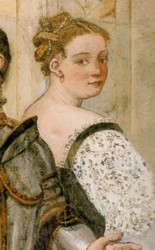 |
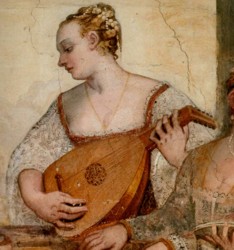 |
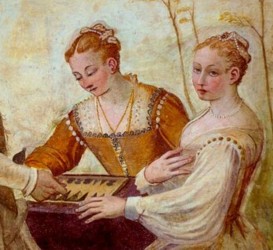 |
| Giovanni Antonio Fasolo, 1565: (fresco detail) Vincenza, Villa Caldogno | Giovanni Antonio Fasolo, 1565: (fresco detail) Vincenza, Villa Caldogno | Giovanni Antonio Fasolo, 1565: (fresco detail) Vincenza, Villa Caldogno |
Chemise appears to a have fixed neckline and cuffs. Viewing some of the cuffs however I suspect that some of these may have been on drawstrings to allow the open look we see on some of these ladies. The necklines while fixed were very open, unlike images of the existent Italian camicia that have closed necks and collars.
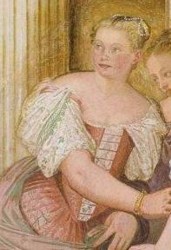 |
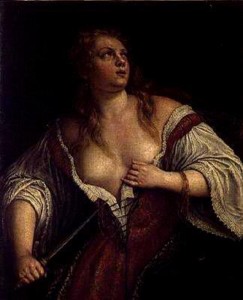 |
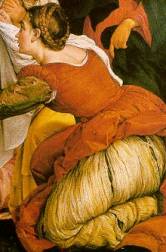 |
| Giovanni Antonio Fasolo, 1565: (fresco detail) Vincenza, Villa Caldogno | Lucretiac Leandro Bassano 1570 medium and location unknown. | The Procession to Calvary, Jacopo Bassano, 1540, oil on canvas 145 x 133 cm, National Gallery, London |
“The Procession to
Calvary”, by Jacopo Bassano shows the chemise clearly displayed with the over
skirt hitched up and the underskirt visible under the chemise.
The joins
in the fabric are evident and some form of embellishment on either side of the
panels can be made out also.
It also appears that there may be an underskirt
worn under the chemise. That being
the colour showing through the gaps in the joins of the chemise.
Whilst
Venetian it is not specifically of my time, it is
nonetheless a lovely illustration of what a chemise looked like and the possible
length
of one.
Adorned with lace, and monochrome embroidery, these were not only functional garments but also ones of great beauty. One thing that should be considered is that the Italians did tend to do their monochrome embroidery a little differently to the English or the Spanish.
The Italians geometry differed from the others, and lovely little repeated patterns that do appear to be different to the English or the Spanish. Some examples of black work/ monochrome can be seen in the images above. Black and red silk are known to be used for monochrome embroidery in the Italian/Venetian genre. The extant chemise above would also indicate lavender coloured silk being used also. Lace was found in white/whitish and in black, and used on personal and bed linens before it was used on more lavish public displays.
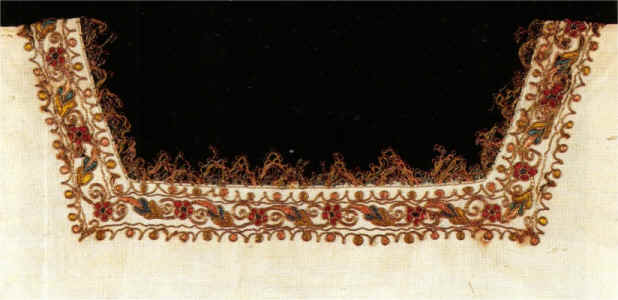 |
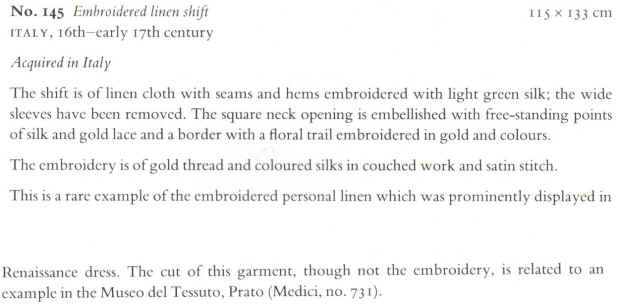 |
| The extant chemise/camica
above polychrome coloured silks being used. While acquired in Italy, it
shares a strong resemblance to a trousseau house in the Metropolitan
Museum of Art, New York. Those garments are now classified as being
of Sicilian origin. In context of time these were created, Sicily
was not part of Italy. It is a beautiful example of lavish polychrome
needle work and polychrome and gold lace embellishments. Whilst not
Venetian, it feels like it could have easily found it's place in a
Venetian wardrobe.
Scanned from European Textiles in the Keir Collection, 400 Bc-1800 Ad (Keir Collection) by Monique King |
Levey S. Patricia Payne Le Pompe, 1559; Patterns for Venetian Bobbin Lace Ruth Bean Farmhouse, Carlton, Bedford, England 1983
Ricci
E. Italian Lace Designs 243 Classic Examples New York Dover 1993
Vinciolo
F. Renaissance Pattern For Lace, Embroidery and Needlepoint: An unabridged
Facimile Of The ‘Singuliers et nouveaux pourtraicts’ of 1587 New York:
Dover 1971
These are great books for those looking for embellishment ideas that are appropriate to the style.
For instruction on how to make a chemise I recommend one of these sites.
http://costume.dm.net/chemise.html Drea Leed
http://www.reconstructinghistory.com/beginners/chemise.html Kas McGann
All intellectual content, composition, layout, designs and photographs, unless otherwise noted are copyright 2007 to Deborah Lane ©, or, copyright 2003 to Deborah Murray © also known as Mistress Oonagh O'Neill ©. All Original renaissance art works and artifacts are not copyright to Deborah Murray, and are shown for educational use only . If you see something you'd really like to use, please contact me!